Potential Benefits of Supplementation with Lecithin-Based Delivery Form of Boswellia serrata Extract and CoQ10 on Amateur Athletes for the Recovery of Acute Traumas or Chronic Musculoskeletal Disorders: A Single-Arm Pilot study
Luca Gatteschi1, Pier Luigi Davolio2, Simona Busi2, Pietro Allegrini3, Giovanna Petrangolini3,
Martino Meneghin3 and Antonella Riva3*
1Centro Gianfortuna, piazza G. Bartali, 14 - 50126 Firenze, Italy
2Farmad Laboratori Firenze SRL, Italy
3Indena SpA, viale Ortles 12, 20139 Milano, Italy
*Corresponding Author: Antonella Riva, Indena SpA, viale Ortles 12, 20139 Milano, Italy;
Received: 22 April 2023; Accepted: 05 May 2023; Published: 14 June 2023
Article Information
Citation: Luca Gatteschi, Pier Luigi Davolio, Simona Busi, Pietro Allegrini, Giovanna Petrangolini, Martino Meneghin and Antonella Riva. Potential Benefits of Supplementation with Lecithin- Based Delivery Form of Boswellia serrata Extract and CoQ10 on Amateur Athletes for the Recovery of Acute Traumas or Chronic Musculoskeletal Disorders : A Single-Arm Pilot study. Journal of Food Science and Nutrition Research. 6 (2023): 56-61.
DOI: 10.26502/jfsnr.2642-110000130
View / Download Pdf Share at FacebookAbstract
A pilot study aimed to evaluate potential advantages of Boswellia and Coenzyme Q10 supplementation was performed in amateur athletes for the recovery from both acute trauma and chronic musculoskeletal conditions such as chondropathy, tendinopathy and meniscopathy. Both Boswellia and Coenzyme Q10 in the present study formulated in phospholipids (Indena Phytosome™ technology) were for the first time combined in the same dietary supplement (WellQ10™). Administration was scheduled for seven days as two tablets two times a day, followed by further two tablets a day for two weeks in acute trauma; and for seven days as two tablets a day, followed by one tablet a day for three weeks in chronic disorders. A significant reduction of pain perception evaluated by VAS score was obtained after supplementation in both acute and chronic conditions. A reduction in recovery time in several amateur athletes with acute trauma was also observed. Boswellia serrata has already been described in Ayuverdic ancient tradition to have well-known anti-inflammatory properties, and Coenzyme Q10 is understood to have antioxidant properties in the context of oxidative stress generated by both strenuous training and sports activity versus trauma. The results achieved in the present study support the beneficial effect of the combination of the two ingredients in a unique supplement. The advantage of using the Phytosome™ delivery technique has opened new perspectives for future applications in the sports trauma recovery field.
Keywords
CoQ10; Coenzyme Q10; Boswellia; Inflammation; Oxidative stress; Sport; Ubiqsome™; Casperome™; WellQ10™; Pain
CoQ10 articles; Coenzyme Q10 articles; Boswellia articles; Inflammation articles; Oxidative stress articles; Sport articles; Ubiqsome? articles; Casperome? articles; WellQ10? articles; Pain articles
CoQ10 articles CoQ10 Research articles CoQ10 review articles CoQ10 PubMed articles CoQ10 PubMed Central articles CoQ10 2023 articles CoQ10 2024 articles CoQ10 Scopus articles CoQ10 impact factor journals CoQ10 Scopus journals CoQ10 PubMed journals CoQ10 medical journals CoQ10 free journals CoQ10 best journals CoQ10 top journals CoQ10 free medical journals CoQ10 famous journals CoQ10 Google Scholar indexed journals Coenzyme Q10 articles Coenzyme Q10 Research articles Coenzyme Q10 review articles Coenzyme Q10 PubMed articles Coenzyme Q10 PubMed Central articles Coenzyme Q10 2023 articles Coenzyme Q10 2024 articles Coenzyme Q10 Scopus articles Coenzyme Q10 impact factor journals Coenzyme Q10 Scopus journals Coenzyme Q10 PubMed journals Coenzyme Q10 medical journals Coenzyme Q10 free journals Coenzyme Q10 best journals Coenzyme Q10 top journals Coenzyme Q10 free medical journals Coenzyme Q10 famous journals Coenzyme Q10 Google Scholar indexed journals Boswellia articles Boswellia Research articles Boswellia review articles Boswellia PubMed articles Boswellia PubMed Central articles Boswellia 2023 articles Boswellia 2024 articles Boswellia Scopus articles Boswellia impact factor journals Boswellia Scopus journals Boswellia PubMed journals Boswellia medical journals Boswellia free journals Boswellia best journals Boswellia top journals Boswellia free medical journals Boswellia famous journals Boswellia Google Scholar indexed journals Inflammation articles Inflammation Research articles Inflammation review articles Inflammation PubMed articles Inflammation PubMed Central articles Inflammation 2023 articles Inflammation 2024 articles Inflammation Scopus articles Inflammation impact factor journals Inflammation Scopus journals Inflammation PubMed journals Inflammation medical journals Inflammation free journals Inflammation best journals Inflammation top journals Inflammation free medical journals Inflammation famous journals Inflammation Google Scholar indexed journals Oxidative stress articles Oxidative stress Research articles Oxidative stress review articles Oxidative stress PubMed articles Oxidative stress PubMed Central articles Oxidative stress 2023 articles Oxidative stress 2024 articles Oxidative stress Scopus articles Oxidative stress impact factor journals Oxidative stress Scopus journals Oxidative stress PubMed journals Oxidative stress medical journals Oxidative stress free journals Oxidative stress best journals Oxidative stress top journals Oxidative stress free medical journals Oxidative stress famous journals Oxidative stress Google Scholar indexed journals Sport articles Sport Research articles Sport review articles Sport PubMed articles Sport PubMed Central articles Sport 2023 articles Sport 2024 articles Sport Scopus articles Sport impact factor journals Sport Scopus journals Sport PubMed journals Sport medical journals Sport free journals Sport best journals Sport top journals Sport free medical journals Sport famous journals Sport Google Scholar indexed journals Ubiqsome™ articles Ubiqsome™ Research articles Ubiqsome™ review articles Ubiqsome™ PubMed articles Ubiqsome™ PubMed Central articles Ubiqsome™ 2023 articles Ubiqsome™ 2024 articles Ubiqsome™ Scopus articles Ubiqsome™ impact factor journals Ubiqsome™ Scopus journals Ubiqsome™ PubMed journals Ubiqsome™ medical journals Ubiqsome™ free journals Ubiqsome™ best journals Ubiqsome™ top journals Ubiqsome™ free medical journals Ubiqsome™ famous journals Ubiqsome™ Google Scholar indexed journals Casperome™ articles Casperome™ Research articles Casperome™ review articles Casperome™ PubMed articles Casperome™ PubMed Central articles Casperome™ 2023 articles Casperome™ 2024 articles Casperome™ Scopus articles Casperome™ impact factor journals Casperome™ Scopus journals Casperome™ PubMed journals Casperome™ medical journals Casperome™ free journals Casperome™ best journals Casperome™ top journals Casperome™ free medical journals Casperome™ famous journals Casperome™ Google Scholar indexed journals WellQ10™ articles WellQ10™ Research articles WellQ10™ review articles WellQ10™ PubMed articles WellQ10™ PubMed Central articles WellQ10™ 2023 articles WellQ10™ 2024 articles WellQ10™ Scopus articles WellQ10™ impact factor journals WellQ10™ Scopus journals WellQ10™ PubMed journals WellQ10™ medical journals WellQ10™ free journals WellQ10™ best journals WellQ10™ top journals WellQ10™ free medical journals WellQ10™ famous journals WellQ10™ Google Scholar indexed journals Pain articles Pain Research articles Pain review articles Pain PubMed articles Pain PubMed Central articles Pain 2023 articles Pain 2024 articles Pain Scopus articles Pain impact factor journals Pain Scopus journals Pain PubMed journals Pain medical journals Pain free journals Pain best journals Pain top journals Pain free medical journals Pain famous journals Pain Google Scholar indexed journals
Article Details
Introduction
Sports injuries are very common events in both professional and amateur athletes and treatment depends on the type and grade of lesions [1]. Supplementation with Coenzyme Q10 (CoQ10) could be helpful in physical activity, training, and sports in order to modulate the oxidative stress generated [2,3]. Indeed, it is known that during high intensity physical activity with oxygen consumption, reactive oxygen species (ROS) are highly produced to cause oxidative stress [4], which acts as the starter of adaptive processes, but at same time could be harmful when elevated. Boswellic acids of Boswellia serrata displayed anti-inflammatory and anti-arthritic properties [5], so the combination of both Boswellia and CoQ10 in one dietary supplement would exert both anti-inflammatory and antioxidant activities to support a fast recovery from sports injuries. The aim of the present study was to evaluate the health benefits of CoQ10 and Boswellia serrata extract formulated with the unique Phytosome™ technology on pain relief in acute and chronic disorders of non-professional athletes.
2. Materials and Methods
2.1. Clinical study
Forty non-professional athletes (between 21 and 59 years old), including 20 (13 males, 7 females) with acute musculoskeletal injury (musculotendinous trauma) and 20 (12 males, 8 females) with chronic musculoskeletal discomfort (joint and tendon overload) were recruited for the study. Subjects with an acute episode (AS) had different degrees of lesions: 4 have a grade 0 lesion (oedema without fibers disruption), 4 have a grade 1 lesion (minimal fibers disruption without blood extravasation), and 12 have a grade 2 lesion (fibers disruption and blood extravasation). Subjects with chronic dysfunctions (CS) showed degenerative cartilagines (n=10) and degenerative
tendon disease (n=10), according to instrumental evaluation such as nuclear magnetic resonance or ultrasound. All subjects exercised daily.
2.2. Experimental design
The Visual Analogue Scale (VAS), which allowed subjects to evaluate their pain level between 0 (“no pain”) and 10 (“worst possible pain”) was detected at 0, 10, and 20 day timepoints. In acute episodes, the objective ultrasound evaluation at the same timepoints was performed. Qualitative data of localized bioimpedance measurements were obtained for some AS in order to analyze muscle injury severity by examining the phase angle, expressing the relationship between the cellular component and liquids locally [6]. The frequency of daily physical activity was also monitored in CS.
2.3. Supplement and administration schedule
Subjects were supplemented with WellQ10TM (FARMAD LABORATORI FIRENZE SRL), containing: CoQ10 Phytosome™ as 150 mg Ubiqsome™ standardized to contain 18-22% of CoQ10, Indena SpA [7], combined with 250 mg Boswellia Phytosome™ (Casperome™ standardized in ≥25% of triterpenoid acids by HPLC, Indena SpA) [8]. AS received two tablets (two times a day) for seven days, followed by two tablets a day for another two weeks.
CS were supplemented with two tablets a day for seven days, followed by one tablet a day for three weeks.
2.4. Statistical evaluation
Data are expressed as means ± S.D. Every data set (acute trauma and chronic disorders as: total; chondropathy; tendinopathy) was independently analysed. Analysis of variance (one-way ANOVA for repeated measures at 0, 10 and 20 days) was performed, followed by Sidaks test for multiple comparisons. Significance was set at p<0.05.
3. Results
Our study was performed on non-professional athletes with characteristics summarized in table 1.
|
Disorder type |
n |
Gender |
Age (years) |
Diagnosis |
|
Acute |
7 |
F |
24.1±3.3 |
Lesions of grade 0, I and II of adductor/quadriceps/triceps/hamstring |
|
13 |
M |
27.4±2.7 |
||
|
Chronic |
8 |
F |
39.9±9.8 |
Chondropathy, meniscopathy, tendinopathy |
|
12 |
M |
41.8±9.8 |
F=female, M=male
Table 1: Summary of characteristics
3.1. Acute traumas
Supplementation with WellQ10 in AS showed a statistically significant reduction of pain, as observed via the VAS score, at day 10 and even more at day 20 in comparison to T0 (Figure 1).
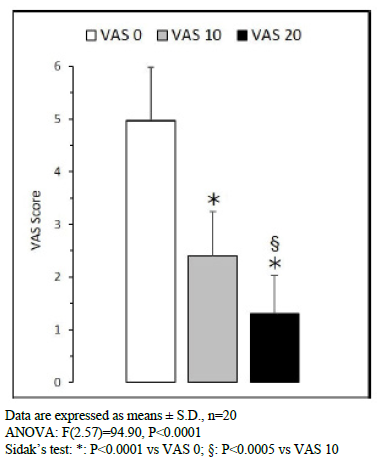
Figure 1: VAS score at time 0, 10 and 20 days after supplementation in AS
In figures 2 and 3, the objective ultrasound evaluation of two AS are shown. An example of grade 1 lesion of thigh flexors was displayed in figure 2: at time zero (Figure 2a) an area of structural disarrangement with increased Doppler signal, indicative of blood flow to the injured area, was noted. At follow-up after supplementation (Figure 2b), signs of hypervascularization were absent and the area of structural damage shows a recovery of the normal architecture of the fibers, with re-absorption of the perilesional edema.
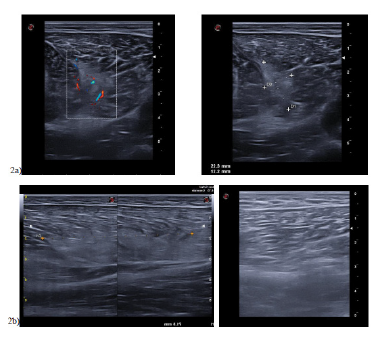
Figure 2: Objective ultrasound evaluation of an acute lesion of tight flexors before (a) and after (b) supplementation, example 1
A second example of a grade 1 lesion of thigh flexors is displayed in figure 3. Area of structural disarrangement and fluid collection with bands of fibrous septae are present at time zero (Figure 3a). After supplementation (Figure 3b), a reabsorption of the fluid component and restoration of the structural damage without detectable fibrotic areas was observed, showing a complete recovery.
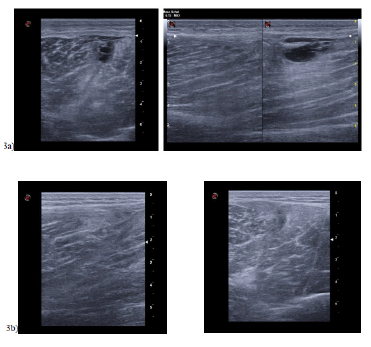
Figure 3: Objective ultrasound evaluation of an acute lesion of tight flexors before (a) and after (b) supplementation, example 2
For some subjects with AS, localized bioimpedance measurements were also performed. Results obtained displayed a qualitative effect on the decrease of muscle injury severity (data not shown). For localized bioimpedance, the phase angle was examined, which is a parameter that expresses the relationship between the cellular components and body fluids. After the injury, the value was reduced due to a local accumulation of liquids and/or to damage to the cellular part [6]. After WellQ10 supplementation, the value recorded in the injured zone was compared with the value of the same contralateral district, taken as control: the recovery of the phase angle vs. control was quicker than that observed in a small group of control subjects not treated with very similar lesions (data not shown).
3.2. Chronic discomforts
WellQ10 supplementation in chronic conditions showed a statistically significant reduction of pain VAS score at day 10 and at day 20 in comparison to T0 (Figure 4).
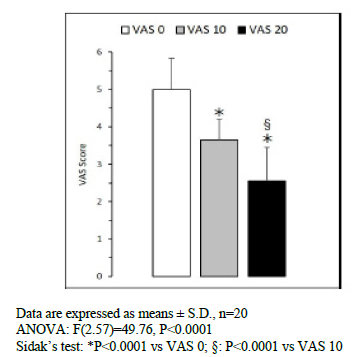
Figure 4: VAS score at time 0, 10 and 20 days after supplementation in CS
By comparing figure 1 and figure 4, we can observe that VAS score reduction after 20 days of supplementation was greater for AS than for CS. The VAS score mean was 1.30±0.73 at T20 vs 4.98±1.01 at T0 for AS; while VAS score mean was 2.55±0.90 at T20 vs 5.0±0.83 at T0 for CS. Of note, the statistical analysis performed on CS pain subgroups (chondropathy and tendinopathy) confirmed a VAS score reduction at both the 10 and 20 day timepoints (Figure 5a, chondropathy and 5b, tendinopathy).
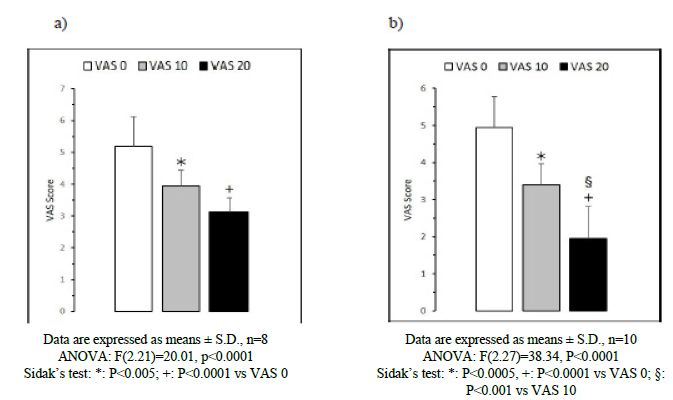
Figure 5: VAS score at time 0, 10 and 20 days after supplementation in chronic disorders as chondropathy (a) and tendinopathy (b)
4. Discussion
Trauma due to sports activities can happen frequently in both professional or amateur athletes. Some lesions of increasing severity can occur to skeletal muscles, and therapies beyond the immediate RICE (rest, ice, compression, elevation) [9], can mainly include the use of classical NSAIDs, i.e. non-steroidal anti-inflammatory drugs. As an alternative to Standard Management, supplementation with natural substances within the time window peculiar to muscle type and individual characteristics, would be useful for two reasons: first for pain relief and second for inflammatory process modulation. Indeed, analgesic effects on the causal mechanism allows for a rapid start of the recovery phase; furthermore an improvement of the healthy inflammatory reaction together with an antioxidant activity and a contribution to a regular production of the mitochondrial energy ensures a decrease in the extent of the damage (i.e. secondary lesions) and the reduction of oedema due to the lesion [10]. In order to support that hypothesis, the present study was conducted in amateur athletes with acute trauma supplemented with the combination of Boswellia and CoQ10, both formulated with Phytosome™ technology. In the same study, subjects having chronic musculoskeletal disorders like chondropathy, tendinopathy, or meniscopathy were also included to evaluate the potential benefits of this supplement in chronic discomforts. The supplementation doses given to AS subjects were higher than that of CS, because it was very important in the first post-lesional phase to immediately reduce inflammatory and oxidant response, without interfering with coagulation mechanisms to avoid establishment or worsening of blood extravasation. That necessity makes it difficult, or not advisable in many cases, to use classical anti-inflammatory therapy and justifies the preferential use of natural substances such as Casperome™ to avoid the known adverse effects discussed above. Results obtained showed a significant reduction in pain intensity already after 10 days of supplementation, and even more at the end of supplementation (20 days), evaluated by VAS score, in acute situations. Noteworthy, objective ultrasound evaluations showed amelioration of target organ tissues. In our study, also chronic, unhealthy dysfunctions were positively modulated through the supplementation. Those results are in agreement with previous studies where after four weeks, Casperome™ supplementation was able to modulate inflammation and osteo-muscular pain in young rugby players [11]. Furthermore, an enhanced recovery from mild severity ankle sprains due to sports training was observed in healthy subjects supplemented with the same product [12]. In the context of knee osteoarthritis, benefits of anti-inflammatory supplements like Boswellia were claimed [13,14]. The importance of the antioxidant activity of CoQ10 in sport was also supported by recent previous studies [2,15], suggesting a CoQ10 protective activity against oxidative stress induced by sports and related trauma. The 30-day supplementation by CoQ10 formulated as Phytosome™ allowed for higher plasmatic and muscular CoQ10 levels than the control group [7,15], with a significant reduction in both inflammatory cytokines and malonyl dialdehyde plasma levels in healthy aging runners after stressful exercise. The Phytosome™ technology applied to both Boswellia and CoQ10 represents a successful delivery system to optimize oral absorption [7,11,15,16]. For the first time, the combination of Casperome™ and Ubiqsome™ present in a unique supplement confirmed and extended the benefits on pain perception in acute traumas and chronic musculoskeletal conditions, possibly due to complementary anti-inflammatory activity related to Boswellia and the antioxidant properties of CoQ10, especially in target tissues. The lack of a control group in the present single-arm pilot study represents the major limitation of the study, together with the lack of biochemical measures. However, ultrasound data for AS clearly showed a recovery from trauma at the tissue level, and the qualitative localized bioimpedance measurements supported the effectiveness of supplementation with WellQ10. For the first time, the present study shows the beneficial properties of two natural substances, Boswellia and CoQ10 both formulated with Phytosome™ technology in a unique, rational combination for the recovery of acute and chronic musculoskeletal disorders in amateur athletes, avoiding side effects often associated with the prolonged use of NSAIDs, and at the same time providing the injured tissues with the protection given by CoQ10. Future studies including a large number of subjects and a control group could be useful to deeply evaluate the potential benefits of this association.
Acknowledgements
We would like to express our gratitude to Dr. Paola Misiano for her valuable editorial support and Dr. Mauro A.M Carai for statistical analysis. This research did not receive any specific grant from funding agencies in the public, or not-forprofit sectors.
Conflict of Interest
AR, PA, GP and MM are Indena’s employees; PLD and SB are employees of FARMAD LABORATORI FIRENZE.
References
- De Sire A, Marotta N, Lippi L, et al. Pharmacological treatment for acute traumatic musculoskeletal pain in athletes. Medicina (Kaunas) 57 (2021).
- Drobnic F, Lizarraga MA, Caballero GA, et al. Coenzyme Q10 Supplementation and Its Impact on Exercise and Sport Performance in Humans: A Recovery or a Performance-Enhancing Molecule? Nutrients 14 (2022): 1811.
- Verhaegen D, Smits K, Osorio N, et al. Oxidative Stress in Relation to Aging and Exercise. Encyclopedia 2 (2022): 1545-1558.
- He L, He T, Farrar S, et al. Antioxidants maintain cellular redox homeostasis by elimination of reactive oxygen species. Cell Physiol Biochem 44 (2017): 532-553.
- Siddiqui MZ. Boswellia serrata, a potential antiinflammatory agent: an overview. Indian J Pharm Sci 73 (2011): 255-61.
- Nescolarde L, Yanguas J, Lukaski H, et al. Effects of muscle injury severity on localized bioimpedance measurements. Physiol Meas 36 (2015): 27-42.
- Petrangolini G, Ronchi M, Frattini E et al. A new food-grade coenzyme Q10 formulation improves bioavailability: Single and Repeated Pharmacokinetic Studies in Healthy Volunteers. Curr Drug Deliv 16 (2019): 759-767.
- Riva A, Morazzoni P, Artaria C, et al. A single-dose, randomized, cross-over, two-way, open-label study for comparing the absorption of boswellic acids and its lecithin formulation. Phytomedicine 23 (2016): 1375-1382.
- Baoge L, Van Den Steen E, Rimbaut S et al. Treatment of skeletal muscle injury: A review. ISRN Orthop (2012): 689012.
- Papadopoulou SK, Mantzorou M, Kondyli SF, et al. The key role of nutritional elements on sport rehabilitation and the effects of nutrients intake. Sports (Basel) 10 (2022).
- Franceschi F, Togni S, Belcaro G, et al. A novel lecithin based delivery form of Boswellic acids (Casperome®) for the management of osteo-muscular pain: a registry study in young rugby players. Eur Rev Med Pharmacol Sci 20 (2016): 4156-4161.
- Feragalli B, Ippolito E, Dugall M, et al. Effectiveness of a novel boswellic acids delivery form (Casperome®) in the management of grade II ankle sprains due to sport trauma - a registry study. Eur Rev Med Pharmacol Sci 21 (2017): 4726-4732.
- Varma K, Haponiuk JT, Gopi S. Inflammation and natural products. Antiinflammatory activity of Boswellia 7 (2021): 568
- Grover AK, Samson SE. Benefits of antioxidant supplements for knee osteoarthritis: rationale and reality. Nutr J 15 (2016): 1.
- Drobnic F, Riera J, Artuch R, et al. Efficient muscle distribution reflects the positive influence of coenzyme Q10 phytosome in healthy aging athletes after stressing exercise. Journal of Food Science and Nutrition Research 3 (2020): 639.
- Riva A, Ronchi M, Petrangolini G, et al. Improved oral absorption of quercetin from quercetin phytosome®, a new delivery system based on food grade lecithin. Eur J Drug Metab Pharmacokinet 44 (2019): 169-177.


 Impact Factor: * 3.8
Impact Factor: * 3.8 Acceptance Rate: 77.96%
Acceptance Rate: 77.96%  Time to first decision: 10.4 days
Time to first decision: 10.4 days  Time from article received to acceptance: 2-3 weeks
Time from article received to acceptance: 2-3 weeks 